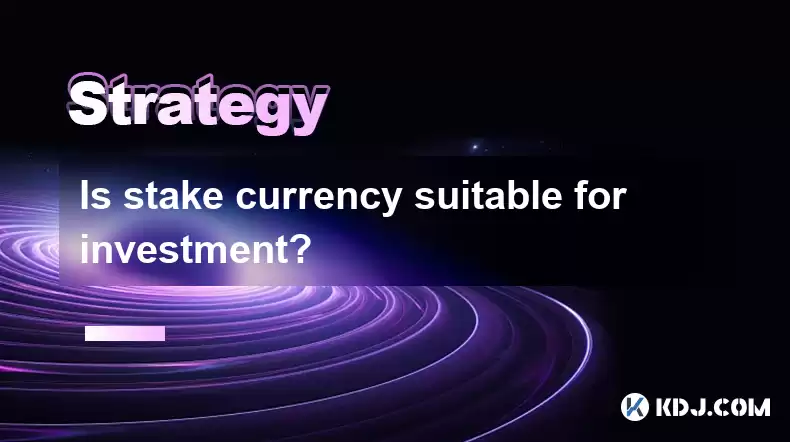-
 Bitcoin
Bitcoin $117800
0.42% -
 Ethereum
Ethereum $4436
0.39% -
 XRP
XRP $3.106
0.86% -
 Tether USDt
Tether USDt $1.001
0.04% -
 BNB
BNB $835.4
1.26% -
 Solana
Solana $188.8
2.21% -
 USDC
USDC $0.9999
0.00% -
 Dogecoin
Dogecoin $0.2302
2.98% -
 TRON
TRON $0.3484
-1.05% -
 Cardano
Cardano $0.9212
-1.20% -
 Hyperliquid
Hyperliquid $46.77
-0.77% -
 Chainlink
Chainlink $22.76
5.64% -
 Stellar
Stellar $0.4278
0.68% -
 Sui
Sui $3.771
2.39% -
 Bitcoin Cash
Bitcoin Cash $583.7
-0.91% -
 Ethena USDe
Ethena USDe $1.001
0.04% -
 Hedera
Hedera $0.2520
2.88% -
 Avalanche
Avalanche $24.28
2.56% -
 Litecoin
Litecoin $120.1
1.44% -
 Toncoin
Toncoin $3.452
1.46% -
 UNUS SED LEO
UNUS SED LEO $9.409
-0.95% -
 Shiba Inu
Shiba Inu $0.00001298
2.02% -
 Uniswap
Uniswap $11.01
3.56% -
 Polkadot
Polkadot $3.962
2.81% -
 Dai
Dai $1.000
0.00% -
 Bitget Token
Bitget Token $4.639
1.16% -
 Cronos
Cronos $0.1511
-0.06% -
 Ethena
Ethena $0.7254
2.87% -
 Monero
Monero $255.7
7.41% -
 Pepe
Pepe $0.00001101
2.80%
Is stake currency suitable for investment?
Investing in stake currencies entails assessing coin fundamentals, proof-of-stake mechanisms, transaction volume, community support, regulatory considerations, and potential returns while mitigating risks through research and diversification.
Jan 12, 2025 at 02:08 pm

Is Stake Currency Suitable for Investment?
Key Points:
- Understanding Staking and Stake Currencies
- Factors to Consider Before Investing in Stake Currencies
Top-Ranked Stake Currencies
- Ethereum (ETH)
- Cardano (ADA)
- Polkadot (DOT)
- Cosmos (ATOM)
- Tezos (XTZ)
Investment Considerations for Stake Currencies
- Potential Returns
- Risks Involved
- Alternatives to Staking
- FAQs Related to Stake Currency Investment
1. Understanding Staking and Stake Currencies
Staking is a process in which cryptocurrency holders contribute their assets to a blockchain network in order to validate transactions and earn rewards. Stake currencies are cryptocurrencies that can be staked, enabling holders to participate in this process.
- Staking strengthens the security of the blockchain by distributing the validation process among multiple parties.
- Staking rewards are typically distributed in the form of new tokens or transaction fees.
- The amount of rewards earned is typically proportional to the number of coins staked and the length of time they are staked for.
2. Factors to Consider Before Investing in Stake Currencies
Before investing in stake currencies, it's crucial to consider the following factors:
- Coin fundamentals: Research the project behind the stake currency, its use cases, and its long-term potential.
- Proof-of-Stake (PoS) mechanism: Understand the specific PoS algorithm used by the blockchain and its impact on rewards and security.
- Transaction volume and fees: High transaction volume and low fees indicate a healthy network with potential for future growth.
- Community support and development activity: A strong community and active development team indicate a project with long-term viability.
- Regulatory environment: Be aware of any regulatory considerations or risks associated with staking currencies in your jurisdiction.
3. Top-Ranked Stake Currencies
- Ethereum (ETH): The leading smart contract platform with a planned transition to a Proof-of-Stake model.
- Cardano (ADA): A purpose-built blockchain for smart contracts and decentralized applications, offering low transaction fees and energy efficiency.
- Polkadot (DOT): A multichain network that connects various blockchains, enabling interoperability and shared security.
- Cosmos (ATOM): A network of interconnected blockchains with a cross-chain staking mechanism.
- Tezos (XTZ): A self-amending blockchain with a strong focus on governance and formal verification.
4. Investment Considerations for Stake Currencies
Potential Returns:
- Staking currencies offer the potential for earning regular rewards through the staking process.
- Rewards can vary significantly depending on the coin, the blockchain used, and market conditions.
- Some stake currencies offer attractive annual returns that can outpace traditional investments.
Risks Involved:
- Stake currencies are subject to the risks of the broader cryptocurrency market, including price volatility and regulatory uncertainty.
- Staking rewards are not guaranteed and can fluctuate.
- Some blockchains require a minimum amount of coins to be staked, which can limit accessibility for smaller investors.
Alternatives to Staking:
- Yield farming: Lending out cryptocurrencies to earn interest.
- Liquidity providing: Supplying liquidity to decentralized exchanges for rewards.
- Cryptocurrency savings accounts: Earning interest on cryptocurrency deposits held in a centralized exchange or wallet.
5. FAQs Related to Stake Currency Investment
Q: What are the benefits of staking stake currencies?
A: Staking stake currencies can generate regular rewards, contribute to blockchain security, and potentially increase the value of the investment.
Q: What is the best stake currency to invest in?
A: The best stake currency for investment will vary depending on individual preferences and investment strategies. Consider factors such as coin fundamentals, PoS mechanism, and market capitalization.
Q: How can I minimize the risks associated with staking stake currencies?
A: Research the coin and its underlying blockchain, stake with a reputable platform, and consider diversifying your portfolio with multiple stake currencies.
Q: Can I stake stake currencies on a hardware wallet?
A: Some hardware wallets support staking for select stake currencies. Check the specific wallet manufacturer for compatibility information.
Q: What are the tax implications of staking stake currencies?
A: Tax implications of staking rewards can vary depending on jurisdiction. Consult with a tax professional for guidance on your specific situation.
Disclaimer:info@kdj.com
The information provided is not trading advice. kdj.com does not assume any responsibility for any investments made based on the information provided in this article. Cryptocurrencies are highly volatile and it is highly recommended that you invest with caution after thorough research!
If you believe that the content used on this website infringes your copyright, please contact us immediately (info@kdj.com) and we will delete it promptly.
- Kazakhstan's Crypto Leap: Bitcoin ETF and Central Asia's Digital Finance Future
- 2025-08-13 12:45:19
- BlockDAG Presale Blazes Past $371M: Fundraising Frenzy Fuels Crypto Sensation
- 2025-08-13 13:05:21
- Meme Coins: Chasing the 2025 Surge – Which Will Moonshot?
- 2025-08-13 10:25:23
- Bitcoin's Wild Ride: Rally, Pullback, and What's Next
- 2025-08-13 10:25:23
- Bitcoin, Bitmax, and Institutional Demand: A New Era of Crypto Investment
- 2025-08-13 10:45:12
- Solana, ROAM, and Airdrops: What's the Buzz in 2025?
- 2025-08-13 11:35:13
Related knowledge

How to use stop-loss orders to limit potential losses?
Aug 08,2025 at 02:01pm
Understanding Stop-Loss Orders in Cryptocurrency TradingA stop-loss order is a risk management tool used by traders to automatically sell a cryptocurr...

What are the most promising altcoins to invest in?
Aug 10,2025 at 11:42am
Understanding the Role of Private Keys in Cryptocurrency WalletsIn the world of cryptocurrency, private keys are the cornerstone of ownership and cont...

Should I invest in Bitcoin or altcoins?
Aug 13,2025 at 11:35am
Understanding Bitcoin and AltcoinsWhen deciding whether to invest in Bitcoin or altcoins, it's essential to first understand what each represents. Bit...

What are the most important metrics to look at when evaluating a cryptocurrency?
Aug 13,2025 at 11:36am
Market Capitalization: Understanding the Total ValueWhen evaluating a cryptocurrency, market capitalization is one of the most foundational metrics. T...

How to read cryptocurrency charts and use technical analysis?
Aug 08,2025 at 11:08am
Understanding the Basics of Cryptocurrency ChartsCryptocurrency charts are graphical representations of price movements over time. These charts are es...

What is the difference between long-term holding (HODLing) and short-term trading?
Aug 10,2025 at 05:30pm
Understanding HODLing in the Cryptocurrency SpaceThe term HODL originated from a typo in a 2013 Bitcoin forum post and has since become a widely accep...

How to use stop-loss orders to limit potential losses?
Aug 08,2025 at 02:01pm
Understanding Stop-Loss Orders in Cryptocurrency TradingA stop-loss order is a risk management tool used by traders to automatically sell a cryptocurr...

What are the most promising altcoins to invest in?
Aug 10,2025 at 11:42am
Understanding the Role of Private Keys in Cryptocurrency WalletsIn the world of cryptocurrency, private keys are the cornerstone of ownership and cont...

Should I invest in Bitcoin or altcoins?
Aug 13,2025 at 11:35am
Understanding Bitcoin and AltcoinsWhen deciding whether to invest in Bitcoin or altcoins, it's essential to first understand what each represents. Bit...

What are the most important metrics to look at when evaluating a cryptocurrency?
Aug 13,2025 at 11:36am
Market Capitalization: Understanding the Total ValueWhen evaluating a cryptocurrency, market capitalization is one of the most foundational metrics. T...

How to read cryptocurrency charts and use technical analysis?
Aug 08,2025 at 11:08am
Understanding the Basics of Cryptocurrency ChartsCryptocurrency charts are graphical representations of price movements over time. These charts are es...

What is the difference between long-term holding (HODLing) and short-term trading?
Aug 10,2025 at 05:30pm
Understanding HODLing in the Cryptocurrency SpaceThe term HODL originated from a typo in a 2013 Bitcoin forum post and has since become a widely accep...
See all articles

























































































